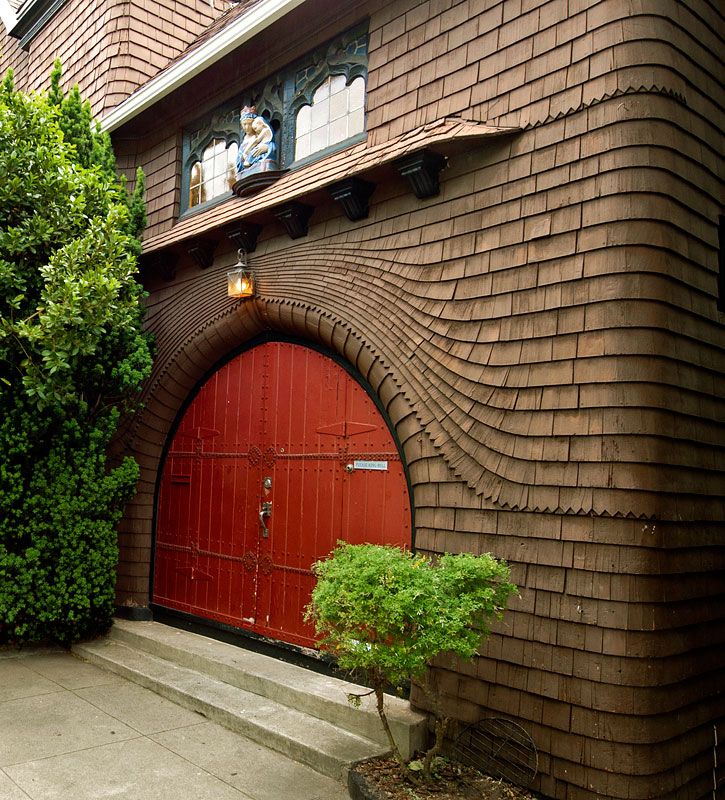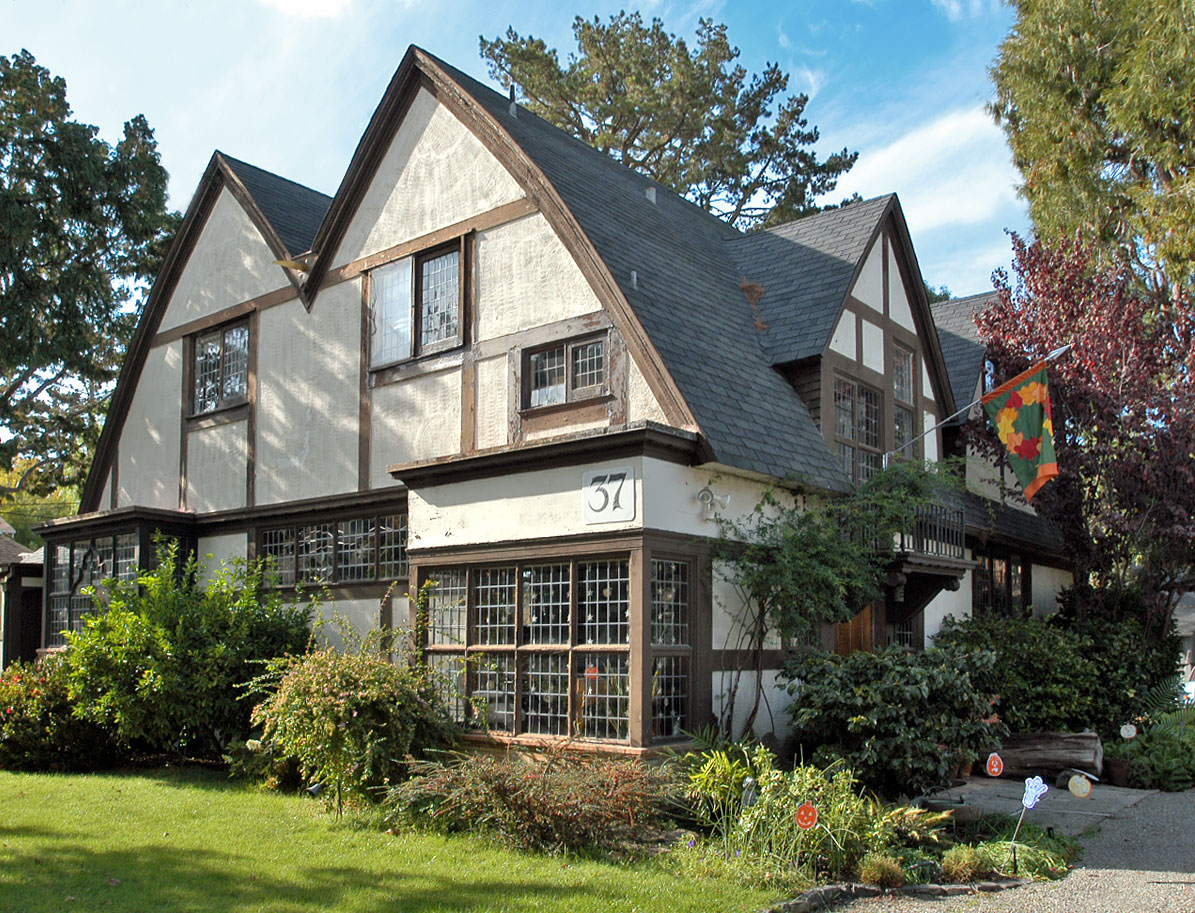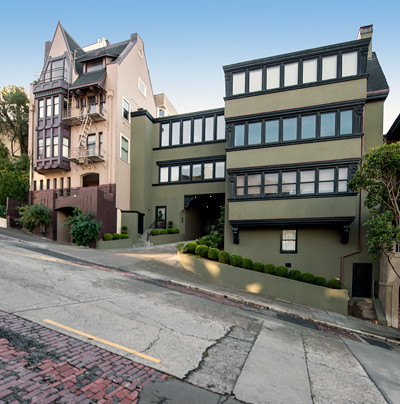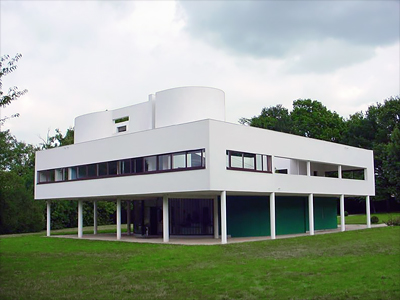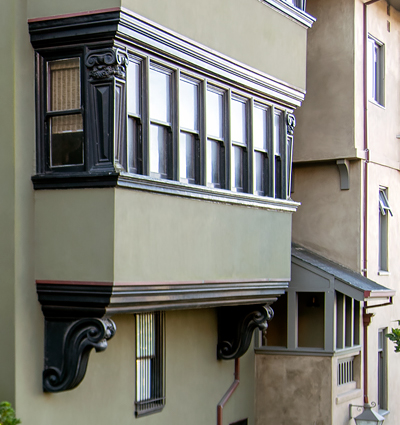Ernest Albert Coxhead (1863-1933)
Ernest Albert Coxhead was born in East Sussex, England. He became an architect through apprenticeship rather than academic training.
When he was fifteen, he began working for a civil engineer who designed public projects and residential developments. After five years, he moved to London where he restored Gothic churches.
In 1886, Albert and his brother Almeric moved to Los Angeles. They established an independent practice and designed several Episcopal Churches in Southern California.
In 1890, the brothers moved to San Francisco. Their firm, Coxhead & Coxhead, built seventeen churches of which eleven are extant. Ernest designed the buildings, and Almeric managed the construction.
After the death of Coxhead's client, Episcopal Bishop William Kip, in 1893, Coxhead & Coxhead turned to residential work in San Francisco, Palo Alto, Alameda and Berkeley.
Coxhead's shingled Arts and Crafts buildings influenced Bay Area architects Bernard Maybeck, Willis Polk, A. Page Brown, John Galen Howard, Julia Morgan, Edgar Mathews, Albert Farr, Joseph Worcester, A. C. Schweinfurth, Louis Christian Mullgardt and other practitioners of the First Bay Tradition.
You can view Coxhead's buildings in chronological order here, or use a link in the following table to visit a specific property.
| Name | Year | Address | City | Sort Address | Sort Name |
|---|---|---|---|---|---|
| Rieber House | 1904 | 15 Canyon Road | Berkeley | Canyon 0015 | Rieber House |
| Garfield Intermediate School | 1915 | 1414 Walnut Street | Berkeley | Walnut 1414 | Garfield Intermediate School |
| Foothills Congregational Church | 1914 | 461 Orange Avenue | Los Altos | Orange | Foothills Congregational Church |
| Chapel of St John the Evangelist | 1891 | 1490 Mark Thomas Drive | Monterey | Mark | Chapel of St John the Evangelist |
| Churchill House | 1892 | 486 Coombs Street | Napa | Coombs 0486 | Churchill House |
| Williams House | 1907 | 351 Homer Avenue | Palo Alto | Homer 0351 | Williams House |
| St. John's Episcopal Church | 1890 | 40 Fifth Street | Petaluma | Street 05 0040 | St. John's Episcopal Church |
| St. Peter's Episcopal Church | 1895 | 510 Jefferson Street | Red Bluff | Jefferson | St. Peter's Episcopal Church |
| Carrigan House | 1892 | 96 Park | San Anselmo | Park 96 | Carrigan House |
| Ferguson House | 1896 | 2511 Baker | San Francisco | Baker 2511 | Ferguson House |
| Osburn House | 1896 | 3362 Clay | San Francisco | Clay 3362 | Osburn House |
| McFarland House | 1895 | 400 Clayton Street | San Francisco | Clayton 0400 | McFarland House |
| Holy Innocents Church | 1890 | 455 Fair Oaks | San Francisco | Fair Oaks 0455 | Holy Innocents Church |
| Bridge over Stow Lake | 1896 | Golden Gate Park | San Francisco | Golden Gate Park | Bridge over Stow Lake |
| Prayerbrook Cross | 1894 | Golden Gate Park | San Francisco | Golden Gate Park | Prayerbrook Cross |
| Home Telephone Company | 1908 | 333 Grant | San Francisco | Grant 0333 | Home Telephone Company |
| Carnegie Library: Golden Gate Valley | 1918 | 1801 Green Street | San Francisco | Green 1901 | Carnegie Library: Golden Gate Valley |
| Coxhead & Coxhead House | 1892 | 2421 Green | San Francisco | Green 2421 | Coxhead & Coxhead House |
| McGauley House | 1891 | 2423 Green | San Francisco | Green 2423 | McGauley House |
| Dettner Printing Co. | 1909 | 835 Howard Street | San Francisco | Howard 0835 | Dettner Printing Co. |
| Brown-Smith House | 1895 | 2600 Jackson | San Francisco | Jackson 2600 | Brown-Smith House |
| Gillespie House | 1894 | 2940 Jackson | San Francisco | Jackson 2940 | Gillespie House |
| Residence | 1902 | 2535 Laguna | San Francisco | Laguna 2525 | Residence |
| Spooner House | 1899 | 2800 Pacific | San Francisco | Pacific 2800 | Spooner House |
| Residence | 1912 | 3153 Pacific | San Francisco | Pacific 3153 | Residence |
| Waybur House | 1901 | 3232 Pacific | San Francisco | Pacific 3232 | Waybur House |
| Porter House | 1901 | 3234 Pacific | San Francisco | Pacific 3234 | Porter House |
| Sonntag House | 1897 | 2700 Scott | San Francisco | Scott 2700 | Sonntag House |
| Murdock House | 1893 | 2710 Scott | San Francisco | Scott 2710 | Murdock House |
| Residence | 1900 | 3647 Washington | San Francisco | Washington 3647 | Residence |
| Coxhead House | 1891 | 37 East Santa Inez Avenue | San Mateo | Santa Inez | Coxhead House |
| Episcopal Church of the Messiah | 1889 | 614 North Bush Street | Santa Ana | Bush | Episcopal Church of the Messiah |
| Sausalito Presbyterian Church | 1909 | 112 Bulkley Avenue | Sausalito | Bulkley | Sausalito Presbyterian Church |
Built 1907
Photographed 17 October 2019
Ernest Coxhead used a Prairie School approach on this stucco house in which modular bands of windows and intervening stucco spandrels are projected from the face of the building.
Source: Here Today: San Francisco's Architectural Heritage by the Junior League of San Francisco, Chronicle Books, 1968

I think that this building anticipated the Bauhaus and International architectural styles by twenty years.
It reminds me of an Arts and Craft forerunner of the Villa Savoye designed by Le Corbusier and built of reinforced concrete in Poissy, France, between 1928 and 1931.
